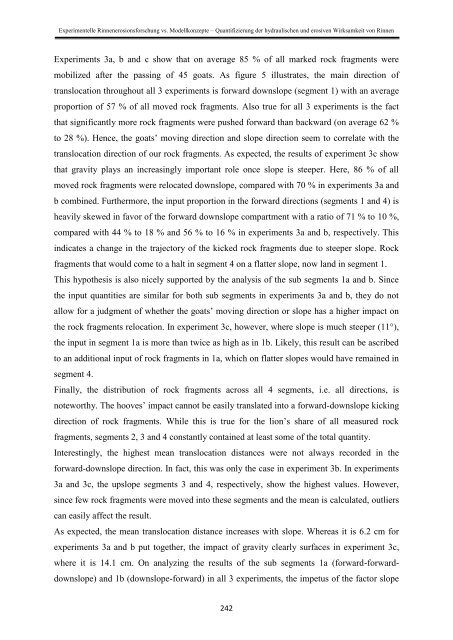Stefan Wirtz Vom Fachbereich VI (Geographie/Geowissenschaften ...
Stefan Wirtz Vom Fachbereich VI (Geographie/Geowissenschaften ...
Stefan Wirtz Vom Fachbereich VI (Geographie/Geowissenschaften ...
Create successful ePaper yourself
Turn your PDF publications into a flip-book with our unique Google optimized e-Paper software.
Experimentelle Rinnenerosionsforschung vs. Modellkonzepte – Quantifizierung der hydraulischen und erosiven Wirksamkeit von Rinnen<br />
Experiments 3a, b and c show that on average 85 % of all marked rock fragments were<br />
mobilized after the passing of 45 goats. As figure 5 illustrates, the main direction of<br />
translocation throughout all 3 experiments is forward downslope (segment 1) with an average<br />
proportion of 57 % of all moved rock fragments. Also true for all 3 experiments is the fact<br />
that significantly more rock fragments were pushed forward than backward (on average 62 %<br />
to 28 %). Hence, the goats’ moving direction and slope direction seem to correlate with the<br />
translocation direction of our rock fragments. As expected, the results of experiment 3c show<br />
that gravity plays an increasingly important role once slope is steeper. Here, 86 % of all<br />
moved rock fragments were relocated downslope, compared with 70 % in experiments 3a and<br />
b combined. Furthermore, the input proportion in the forward directions (segments 1 and 4) is<br />
heavily skewed in favor of the forward downslope compartment with a ratio of 71 % to 10 %,<br />
compared with 44 % to 18 % and 56 % to 16 % in experiments 3a and b, respectively. This<br />
indicates a change in the trajectory of the kicked rock fragments due to steeper slope. Rock<br />
fragments that would come to a halt in segment 4 on a flatter slope, now land in segment 1.<br />
This hypothesis is also nicely supported by the analysis of the sub segments 1a and b. Since<br />
the input quantities are similar for both sub segments in experiments 3a and b, they do not<br />
allow for a judgment of whether the goats’ moving direction or slope has a higher impact on<br />
the rock fragments relocation. In experiment 3c, however, where slope is much steeper (11°),<br />
the input in segment 1a is more than twice as high as in 1b. Likely, this result can be ascribed<br />
to an additional input of rock fragments in 1a, which on flatter slopes would have remained in<br />
segment 4.<br />
Finally, the distribution of rock fragments across all 4 segments, i.e. all directions, is<br />
noteworthy. The hooves’ impact cannot be easily translated into a forward-downslope kicking<br />
direction of rock fragments. While this is true for the lion’s share of all measured rock<br />
fragments, segments 2, 3 and 4 constantly contained at least some of the total quantity.<br />
Interestingly, the highest mean translocation distances were not always recorded in the<br />
forward-downslope direction. In fact, this was only the case in experiment 3b. In experiments<br />
3a and 3c, the upslope segments 3 and 4, respectively, show the highest values. However,<br />
since few rock fragments were moved into these segments and the mean is calculated, outliers<br />
can easily affect the result.<br />
As expected, the mean translocation distance increases with slope. Whereas it is 6.2 cm for<br />
experiments 3a and b put together, the impact of gravity clearly surfaces in experiment 3c,<br />
where it is 14.1 cm. On analyzing the results of the sub segments 1a (forward-forwarddownslope)<br />
and 1b (downslope-forward) in all 3 experiments, the impetus of the factor slope<br />
242
















